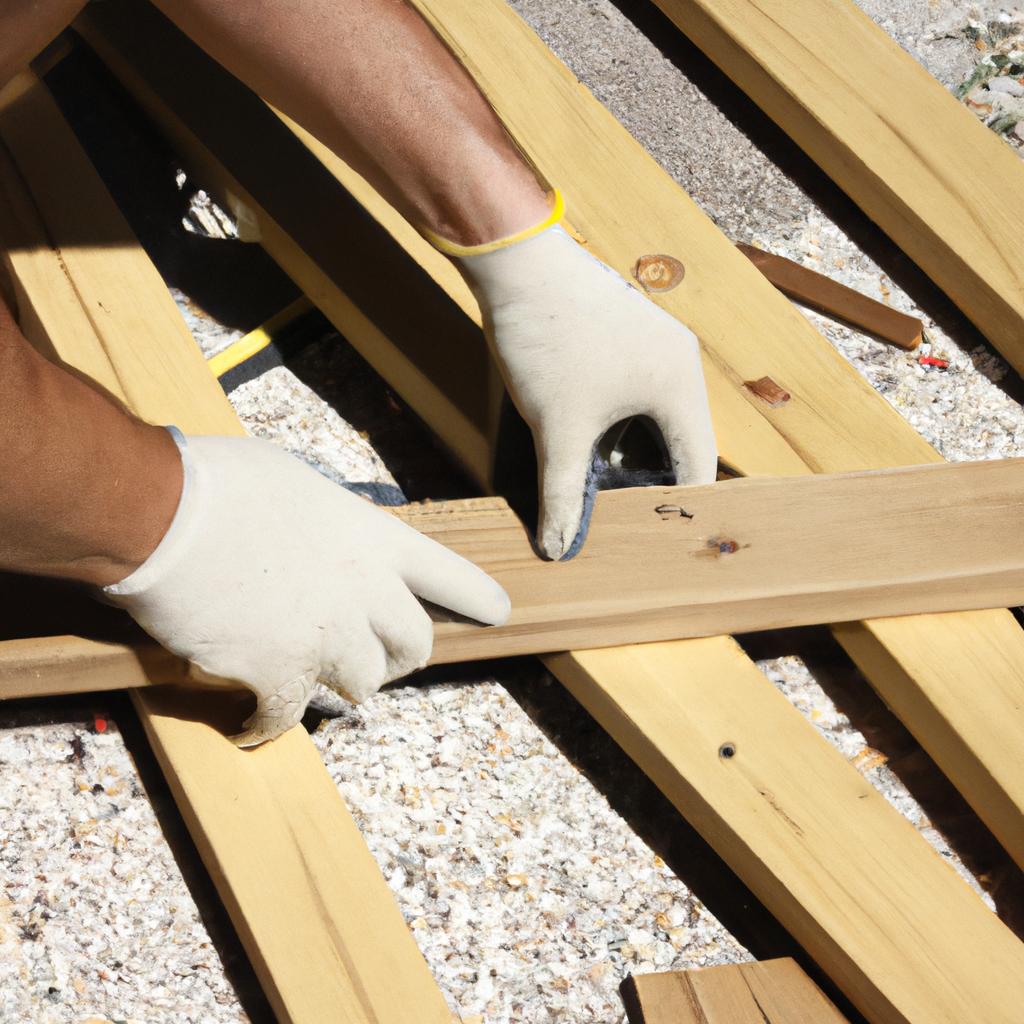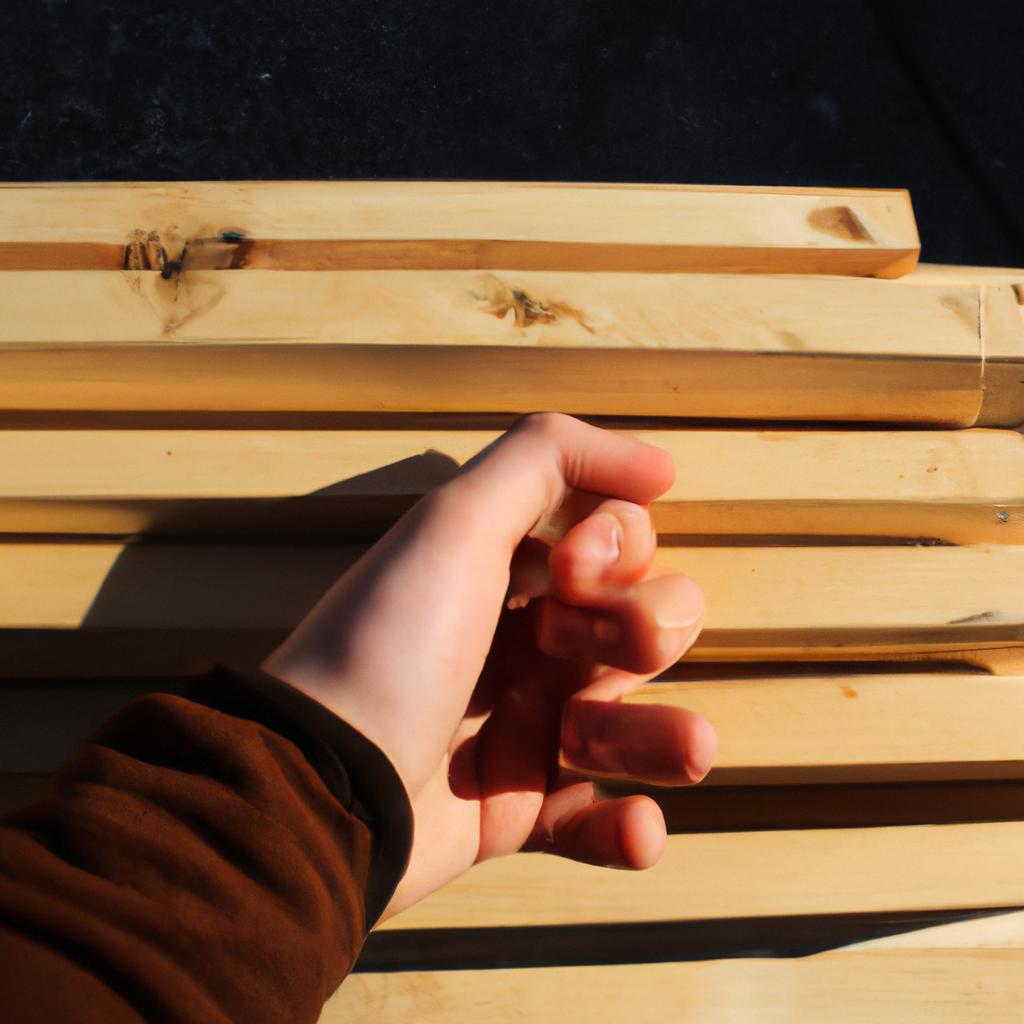Wood studs are an essential component in the construction industry, providing structural support and stability to buildings. With a plethora of options available, it is crucial for builders and contractors to have a comprehensive understanding of the various types of wood studs commonly used in lumber and building materials. This article aims to provide a detailed guide on different types of wood studs, their characteristics, applications, advantages, and disadvantages.
Imagine this scenario: A builder embarks on a project to construct a residential house with multiple stories. As they begin framing the structure, they face a dilemma – which type of wood stud should be chosen? Should they opt for traditional dimensional lumber or explore engineered studs such as laminated veneer lumber (LVL) or parallel strand lumber (PSL)? These questions highlight the importance of making informed decisions when selecting wood studs suitable for specific construction purposes. By delving into the variety offered by modern technology and innovations within the realm of wooden building materials, this article seeks to equip professionals in the field with valuable knowledge necessary for successful projects.
Dimensional Lumber Studs
Dimensional Lumber Studs
Imagine you are building a new home, and one of the critical elements to consider is the choice of wood studs. These vertical framing members provide structural support to walls in residential and commercial construction projects. In this section, we will explore dimensional lumber studs, which are commonly used due to their availability and affordability.
Dimensional lumber refers to wood boards that have been milled to standardized dimensions. The most widely used material for dimensional lumber studs is softwood, such as pine or fir. Softwoods possess desirable properties like high strength-to-weight ratio and ease of workability. For instance, let’s consider an example where a builder opts for 2×4 (nominal size) pine studs with actual dimensions of 1.5 inches by 3.5 inches.
- Cost-effective: Dimensional lumber studs are readily available at affordable prices.
- Versatility: They can be easily cut and shaped according to specific construction requirements.
- Strength: Despite being lightweight, dimensional lumber exhibits considerable load-bearing capacity.
- Sustainability: Many suppliers offer certified sustainable options from responsibly managed forests.
Additionally, we can present information using a table format:
| Pros | Cons |
|---|---|
| Cost-effective | Prone to warping |
| Versatile | Susceptible to insect damage |
| Strong | Limited span capabilities |
| Sustainable | Shrinking or expanding with moisture |
In conclusion, dimensional lumber studs serve as reliable building blocks when constructing walls due to their cost-effectiveness, versatility, strength, and sustainability aspects. However, it is important to note potential drawbacks related to warping, vulnerability to insects, limited span capabilities, and sensitivity to moisture. In the subsequent section, we will explore another category of wood studs known as engineered wood studs.
Moving forward, let us delve into the realm of engineered wood studs to understand their unique characteristics and benefits without any delay.
Engineered Wood Studs
Types of Wood Studs: A Comprehensive Guide for Lumber and Building Materials
…
Dimensional Lumber Studs have long been a popular choice in construction projects due to their affordability and availability. However, there are other types of wood studs that offer unique advantages as well. In this section, we will explore the benefits of Engineered Wood Studs.
Imagine a scenario where you need to construct an interior wall that requires additional strength and stability. Engineered Wood Studs can be the perfect solution in such cases. These studs are typically made by combining layers of high-quality lumber with adhesives or fasteners, resulting in a product that offers superior durability and load-bearing capacity.
Here are some key reasons why Engineered Wood Studs should be considered:
- Enhanced Strength: Engineered Wood Studs have greater strength compared to traditional dimensional lumber studs, making them ideal for supporting heavy loads.
- Greater Stability: Due to their manufacturing process, engineered wood studs are less prone to warping, twisting, or splitting, ensuring better stability over time.
- Consistent Quality: Unlike natural dimensional lumber, which may vary in quality from one piece to another, engineered wood studs provide consistent performance throughout the project.
- Environmental Sustainability: Many manufacturers use sustainable practices when producing engineered wood studs, contributing to a greener approach in construction.
To further illustrate the benefits mentioned above, consider the following comparison between Dimensional Lumber Studs and Engineered Wood Studs:
| Features | Dimensional Lumber Studs | Engineered Wood Studs |
|---|---|---|
| Load-Bearing Capacity | Good | Excellent |
| Resistance to Warping | Fair | Very Good |
| Consistency | Varies | High |
| Sustainable Manufacturing | Varies | Yes |
As evident from the table above, using engineered wood studs can significantly enhance structural integrity while offering greater stability and consistency throughout the construction process.
In the subsequent section, we will explore another alternative to wood studs: Metal Studs. These versatile components have gained popularity in recent years for their unique properties and applications in various types of construction projects.
Metal Studs
Types of Wood Studs: A Comprehensive Guide for Lumber and Building Materials
…
Engineered Wood Studs have proven to be a popular alternative to traditional wood studs due to their enhanced strength and versatility. One such example is the use of laminated veneer lumber (LVL) studs in a residential construction project. In this case, the builder opted for LVL studs instead of conventional lumber studs because they offered greater load-bearing capacity and resistance to warping or twisting.
When considering engineered wood studs, there are several key advantages worth noting:
- Increased dimensional stability: Engineered wood studs are less susceptible to shrinking or swelling caused by changes in temperature or humidity.
- Enhanced strength-to-weight ratio: Compared to solid wood studs, engineered alternatives often exhibit superior load-bearing capabilities while being lighter in weight.
- Consistent quality: Due to their manufacturing process, engineered wood studs tend to have fewer knots, splits, or other imperfections commonly found in natural timber.
- Environmental sustainability: Many types of engineered wood used for stud construction are made from sustainably harvested materials or consist of recycled content.
To further illustrate the benefits of engineered wood studs, consider the following comparison table showcasing their characteristics compared with traditional lumber and metal counterparts:
| Characteristic | Engineered Wood Studs | Traditional Lumber Studs | Metal Studs |
|---|---|---|---|
| Strength | High | Medium | Low |
| Dimensional Stability | High | Low | High |
| Weight | Light | Heavy | Light |
| Resistance | Rot/Warp/Twist | Warping/Twisting | Rust |
As evident above, engineered wood studs surpass both traditional lumber and metal options in terms of strength and dimensional stability while providing a lightweight solution. These attributes make them an excellent choice for various applications ranging from single-family homes to commercial buildings.
Moving forward, the next section will delve into an alternative type of stud known as Composite Studs, which offer yet another set of benefits and considerations for builders seeking solutions that cater to specific project requirements.
Composite Studs
Types of Wood Studs: A Comprehensive Guide for Lumber and Building Materials
Metal studs have long been a popular choice in construction due to their durability, fire resistance, and ability to resist rotting. However, there is another option that has gained traction in recent years – composite studs. These innovative materials offer a unique combination of strength and sustainability, making them an attractive alternative.
Imagine this scenario: You are a contractor working on a project that requires the use of wood studs. In your search for the right material, you come across composite studs. Intrigued by their potential benefits, you decide to delve deeper into understanding these modern building components.
Composite studs have several advantages over traditional metal or wooden studs. First and foremost, they are made from recycled materials such as plastic and sawdust, reducing waste and promoting environmental sustainability. Additionally, composite studs do not warp or twist like natural wood does when exposed to moisture or extreme temperature changes. This eliminates the need for constant monitoring and maintenance during the lifetime of a structure.
To further illustrate the benefits of composite studs, consider the following:
- Enhanced insulation properties: Composite studs provide better thermal insulation compared to metal counterparts.
- Improved soundproofing capabilities: The composition of these studs helps reduce noise transmission between rooms.
- Resistance to pests: Unlike natural wood, which is susceptible to termite infestation or decay caused by fungi, composite studs are inherently resistant.
- Versatility in design: Composite studs can be easily manipulated into different shapes and sizes without compromising structural integrity.
Table: Comparison Between Metal Studs and Composite Studs
| Features | Metal Studs | Composite Studs |
|---|---|---|
| Durability | Prone to corrosion | Highly durable |
| Environmental Impact | High carbon footprint | Made from recycled materials |
| Moisture Resistance | Susceptible to warping | Resistant to warping |
| Insulation Properties | Poor thermal insulation | Enhanced thermal insulation |
As we explore the world of wood studs, it becomes evident that composite studs offer an innovative solution for modern construction needs. Their eco-friendly nature, durability, and resistance to common issues faced by traditional wooden or metal studs make them a compelling choice for builders seeking sustainable alternatives.
Moving forward in our exploration of different types of wood studs, let’s now turn our attention to specialty wood studs—a category that encompasses a wide range of unique materials and designs.
Specialty Wood Studs
Composite Studs are a popular alternative to traditional wood studs in construction projects. These innovative studs combine different materials, such as engineered wood and recycled plastics, to create a durable and sustainable building material. One example of the use of composite studs is in eco-friendly housing developments where sustainability is prioritized.
There are several benefits of using composite studs in construction projects:
- Environmental Sustainability: Composite studs often incorporate recycled materials, reducing waste and promoting environmentally friendly practices.
- Increased Strength: The combination of different materials strengthens the stud, making it more resistant to warping or bending under heavy loads.
- Termite Resistance: Unlike traditional wood studs that can be susceptible to termite damage, composite studs offer increased resistance against these pests.
- Consistent Quality: Composite studs are manufactured with precise specifications, ensuring consistent quality throughout each piece.
To illustrate the advantages further, consider the following comparison table showcasing the differences between traditional wood studs and composite studs:
| Traditional Wood Studs | Composite Studs | |
|---|---|---|
| Environmental | Prone to deforestation | Made from |
| Impact | recycled | |
| materials | ||
| Structural | Can warp or bend | Stronger and |
| Integrity | under heavy loads | more resilient |
| Pest Resistance | Susceptible to termites | Termite-resistant |
| Consistency & Quality | Varies depending on | Manufactured |
| supplier |
Transitioning into our next section about Specialty Wood Studs
Reclaimed Wood Studs
Types of Wood Studs: A Comprehensive Guide for Lumber and Building Materials
Specialty Wood Studs
In the previous section, we explored the various types of wood studs commonly used in construction projects. Now let’s delve into a category of wood studs that offers unique characteristics and applications – specialty wood studs.
To illustrate the versatility of specialty wood studs, consider the case study below:
Case Study: In a high-end residential project, architects sought to create an aesthetically pleasing interior while maintaining structural integrity. They opted for clear vertical-grain Douglas fir studs as they provide both strength and beauty. These specialty wood studs were carefully selected to enhance the overall design scheme, exhibiting their natural grain patterns and warm tones throughout the space.
When it comes to specialty wood studs, there are several options available. Here are some noteworthy examples:
- Clear Vertical-Grain Douglas Fir: Known for its stability and durability, this type of stud is often chosen for premium applications where aesthetics play a crucial role.
- Cedar: Renowned for its resistance to decay and insect damage, cedar studs are frequently employed in outdoor structures such as decks and pergolas.
- Engineered Wood: Combining multiple layers of lumber with adhesives, engineered wood studs offer superior strength and dimensional stability compared to traditional solid wood.
- Treated Lumber: Treated lumber boasts enhanced resistance against rotting, termites, and fungal decay due to chemical treatments during production.
To further emphasize the benefits these specialty wood studs can bring to your construction project, consider the following table:
| Specialty Wood Stud | Key Advantages |
|---|---|
| Clear Vertical-Grain | – Enhanced aesthetics |
| Douglas Fir | – High dimensional stability |
| Cedar | – Natural resistance to decay |
| Engineered Wood | – Superior strength |
| Treated Lumber | – Increased resistance against rot and termites |
By incorporating specialty wood studs into your building design, you can achieve both structural integrity and visual appeal. Whether you prioritize aesthetics, durability, or specific performance attributes, there is a specialty wood stud to meet your requirements.
In summary, specialty wood studs offer unique characteristics that make them ideal for various construction projects. From clear vertical-grain Douglas fir to treated lumber, these studs provide exceptional strength, beauty, and resistance to environmental factors. Consider integrating specialty wood studs into your next project for an added touch of elegance and functionality.
 Bergmann Lumber
Bergmann Lumber



